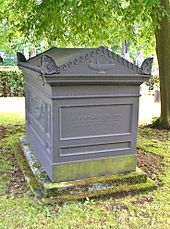Tumba


Tumba , also called high grave , refers to a free-standing stone or metal tomb in the form of a sarcophagus . In contrast to the sarcophagus, the tumba does not contain the bones of the dead; however, this differentiation is not always uniform.
Box tumba and base tumba
A Tumba is commonly made of four side plates and a top plate, resulting in a box-like effect of the structure which the term Kastentumba coined. A plinth rises under the empty box monument on all the monuments preserved in the study area; here the concept of the base tumba seems appropriate. Such a monument represents z. B. the double umba for Günther XXV. von Schwarzburg († 1386) with his wife Elisabeth († 1381).
The window tumba
The so-called window tumba forms a variant of the box tumba or a typological intermediate stage on the way to the table tomb. Formally largely comparable to the Kastentumba, the box walls show one or more openings that allow a view into the interior of the high tomb. On the tumba walls of the monument to Landgrave Otto von Hessen († 1328) (Marburg Elisabethkirche ) there are also eight pleureurs ("weeping ends") set under some pointed arcades. However, some of the arcade arches remain open and provide an insight into the empty interior of the tumba.
Tumba as a false coffin
Until the liturgical reform as a result of the Second Vatican Council , it was common practice in the Catholic Church, if the coffin was not in the church for the Requiem , to set up a wooden, usually collapsible, slatted frame with a black cover, the so-called tumba , as a dummy coffin. At the end of the funeral mass, the Absolutio super tumulum (Latin, “ absolution over the grave”), an intercessory prayer for the deceased, was spoken or sung and the blessing was given. In the ordinary form of the Roman rite , the tumba and other symbols representing the coffin with the corpse have been abolished. Where possible, it is recommended that the coffin with the body be brought to the church for the celebration of the Requiem.
literature
- Jürgen Bärsch : All Souls' Day. Studies on the liturgy and customs of a day of remembrance of the dead in the Western Church. Aschendorff Verlag, Münster 2004, ISBN 3-402-04069-7 .
- Hans Körner: Grave monuments of the Middle Ages. Primus-Verlag, Darmstadt 1997, ISBN 3-89678-042-5 .
-
The stone high tomb (tombes levées): Kastentumba und Sockeltumba - Die Fenstertumba - ... In: Helga Wäß: Form and perception of Central German memory sculpture in the 14th century. Tenea, Bristol / Berlin 2006, ISBN 3-86504-159-0 .
- Volume 1: A contribution to medieval grave monuments, epitaphs and curiosities in Saxony, Saxony-Anhalt, Thuringia, North Hesse, East Westphalia and South Lower Saxony.
- Volume 2: Catalog of selected objects from the High Middle Ages to the beginning of the 15th century. S. 159 ff., 292 ff. (Recorded around 1000 monuments / partly with illustration)
Web links
Individual evidence
- ^ Robert B. Witte: The Catholic house of God. Its construction, its equipment, its care, Mainz 1939, pp. 273–274.
- ^ Andreas Heinz : Tumba . In: Walter Kasper (Ed.): Lexicon for Theology and Church . 3. Edition. tape 10 . Herder, Freiburg im Breisgau 2001, Sp. 304 .
- ↑ Anselm Schott : The complete Roman missal. Herder, Freiburg i. Br. 1963, pp. [224] - [227].
- ^ The church funeral service in the Catholic dioceses of the German-speaking area. 2nd edition, Leipzig 1988, ISBN 3-7462-0260-4 , p. 19, p. 31.
